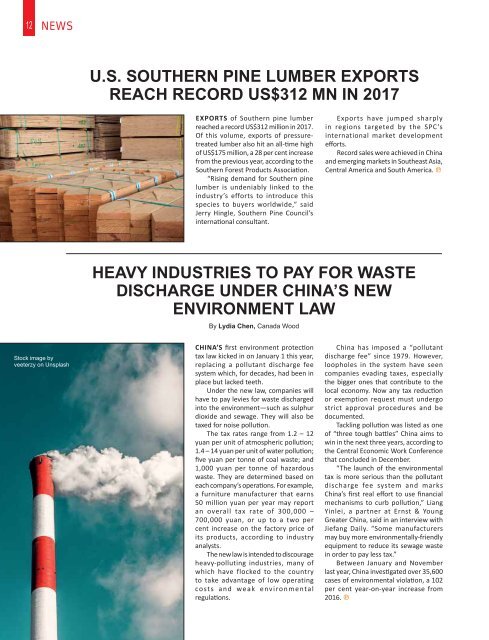Panels & Furniture Asia March/April 2018
Panels & Furniture Asia (PFA) is a leading regional trade magazine dedicated to the woodbased panel, furniture and flooring processing industry. Published bi-monthly since 2000, PFA delivers authentic journalism to cover the latest news, technology, machinery, projects, products and trade events throughout the sector. With a hardcopy and digital readership comprising manufacturers, designers and specifiers, among others, PFA is the platform of choice for connecting brands across the global woodworking landscape.
Panels & Furniture Asia (PFA) is a leading regional trade magazine dedicated to the woodbased panel, furniture and flooring processing industry. Published bi-monthly since 2000, PFA delivers authentic journalism to cover the latest news, technology, machinery, projects, products and trade events throughout the sector. With a hardcopy and digital readership comprising manufacturers, designers and specifiers, among others, PFA is the platform of choice for connecting brands across the global woodworking landscape.
Create successful ePaper yourself
Turn your PDF publications into a flip-book with our unique Google optimized e-Paper software.
12 NEWS<br />
U.S. SOUTHERN PINE LUMBER EXPORTS<br />
REACH RECORD US$312 MN IN 2017<br />
EXPORTS of Southern pine lumber<br />
reached a record US$312 million in 2017.<br />
Of this volume, exports of pressuretreated<br />
lumber also hit an all-time high<br />
of US$175 million, a 28 per cent increase<br />
from the previous year, according to the<br />
Southern Forest Products Association.<br />
“Rising demand for Southern pine<br />
lumber is undeniably linked to the<br />
industry’s efforts to introduce this<br />
species to buyers worldwide,” said<br />
Jerry Hingle, Southern Pine Council’s<br />
international consultant.<br />
Exports have jumped sharply<br />
in regions targeted by the SPC’s<br />
international market development<br />
efforts.<br />
Record sales were achieved in China<br />
and emerging markets in Southeast <strong>Asia</strong>,<br />
Central America and South America. ℗<br />
HEAVY INDUSTRIES TO PAY FOR WASTE<br />
DISCHARGE UNDER CHINA’S NEW<br />
ENVIRONMENT LAW<br />
By Lydia Chen, Canada Wood<br />
Stock image by<br />
veeterzy on Unsplash<br />
CHINA’S first environment protection<br />
tax law kicked in on January 1 this year,<br />
replacing a pollutant discharge fee<br />
system which, for decades, had been in<br />
place but lacked teeth.<br />
Under the new law, companies will<br />
have to pay levies for waste discharged<br />
into the environment—such as sulphur<br />
dioxide and sewage. They will also be<br />
taxed for noise pollution.<br />
The tax rates range from 1.2 – 12<br />
yuan per unit of atmospheric pollution;<br />
1.4 – 14 yuan per unit of water pollution;<br />
five yuan per tonne of coal waste; and<br />
1,000 yuan per tonne of hazardous<br />
waste. They are determined based on<br />
each company’s operations. For example,<br />
a furniture manufacturer that earns<br />
50 million yuan per year may report<br />
an overall tax rate of 300,000 –<br />
700,000 yuan, or up to a two per<br />
cent increase on the factory price of<br />
its products, according to industry<br />
analysts.<br />
The new law is intended to discourage<br />
heavy-polluting industries, many of<br />
which have flocked to the country<br />
to take advantage of low operating<br />
costs and weak environmental<br />
regulations.<br />
China has imposed a “pollutant<br />
discharge fee” since 1979. However,<br />
loopholes in the system have seen<br />
companies evading taxes, especially<br />
the bigger ones that contribute to the<br />
local economy. Now any tax reduction<br />
or exemption request must undergo<br />
strict approval procedures and be<br />
documented.<br />
Tackling pollution was listed as one<br />
of “three tough battles” China aims to<br />
win in the next three years, according to<br />
the Central Economic Work Conference<br />
that concluded in December.<br />
“The launch of the environmental<br />
tax is more serious than the pollutant<br />
discharge fee system and marks<br />
China’s first real effort to use financial<br />
mechanisms to curb pollution,” Liang<br />
Yinlei, a partner at Ernst & Young<br />
Greater China, said in an interview with<br />
Jiefang Daily. “Some manufacturers<br />
may buy more environmentally-friendly<br />
equipment to reduce its sewage waste<br />
in order to pay less tax.”<br />
Between January and November<br />
last year, China investigated over 35,600<br />
cases of environmental violation, a 102<br />
per cent year-on-year increase from<br />
2016. ℗<br />
<strong>March</strong> / <strong>April</strong> <strong>2018</strong> • Issue 2 • PANELS & FURNITURE ASIA


















